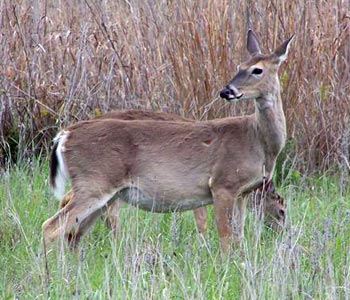Harvest an antlerless deer in 2013 to support Michigan farmers
Taking a doe from Michigan farmland can help producers reduce crop damage while improving overall health of the deer herd.
 Ask a white-tailed deer hunter to describe their ideal quarry and the conversation will almost invariably turn to antlers. The myth of The Stag has permeated hunting culture since a time when social media consisted of pictographs on cave walls. Today, mature male deer represent a shrewd, ethereal dominance that is codified in human folklore worldwide. The desire to test one’s skill against such a formidable animal can be so strong that many American hunters claim to be overcome annually by the symptoms of an ill-defined condition termed “buck fever.”
Ask a white-tailed deer hunter to describe their ideal quarry and the conversation will almost invariably turn to antlers. The myth of The Stag has permeated hunting culture since a time when social media consisted of pictographs on cave walls. Today, mature male deer represent a shrewd, ethereal dominance that is codified in human folklore worldwide. The desire to test one’s skill against such a formidable animal can be so strong that many American hunters claim to be overcome annually by the symptoms of an ill-defined condition termed “buck fever.”
A female white-tailed deer: the ideal target for hunters seeking high-quality venison, crop damage control and a healthy herd. Photo credit: Karan Rawlins, University of Georgia
However, bucks more than 3.5 years old, the ones that inspire storytellers, can be difficult to find. In much of Michigan, particularly the northeast and southern Lower Peninsula, deer population densities are above MDNR goals based on environmental and social carrying capacities. Here there are plenty of deer, too many really. Yet, because more male than female deer are harvested each year, many of these large herds consist predominantly of does and young bucks.
Aside from producing few mature bucks for harvest, overpopulated white-tail herds also exacerbate deer-human conflicts. In our agriculturally rich state, where nearly 55,000 farms cultivate approximately 10 million acres, these conflicts often come in the form of crop damage. Exclusion research conducted by Michigan State University Extension in the late 1980s found that kidney bean yields were reduced by 24-43 percent, and alfalfa yields 18.7 percent, due to deer feeding. While regional population estimates have shifted significantly in the 25 years since this data was collected, current statewide deer numbers are actually quite similar to that period – about 1,600,000. Crop damage remains so costly in areas with high deer densities that farmers there identify it as the most challenging production problem they face.
Wildlife biologists suggest that the best way to mitigate crop damage and simultaneously increase the number of mature bucks is to focus management efforts on correcting the overabundance of female deer. Selectively harvesting female deer decreases overall population density by limiting the herd’s reproductive potential. Fewer deer means less crop depredation. Taking does rather than young bucks also allows more male deer to survive and grow larger, improving hunters’ chances of eventually living their big buck dreams. After about five years of adjusted hunting behavior, groups of mature bucks become available each season for harvest. Sounds ideal, right?
While browsing is the primary way deer damage agricultural crops, it is important to note how thinning the herd and allowing bucks to mature can contribute to a different kind of loss on the farm. One of the ways male deer display their sexual dominance and locate females in their territory is rubbing. Antlers are used to rub pheromones onto small trees and branches. Unfortunately, young orchard blocks are a rubbing paradise, and bigger bucks make bigger rubs. Excessive rubbing can girdle fruit trees and cost growers thousands of dollars per acre. In regions that produce perennial tree fruit crops, antlerless deer harvest may function better as a compliment to, rather than a replacement for, the taking of younger male deer 1.5 to 2.5 years of age.
In Michigan, antlerless deer harvest is managed according to a quota and permitting system by geographic Deer Management Units (DMUs). Antlerless permits are not available in the few areas where deer population densities are below goal, including the northern Upper Peninsula. However, in the rest of the state where antlerless harvest is prescribed, doe kill numbers consistently fall short of DNR targets.
If you plan to participate in the 2013 white-tailed deer hunting season, consider the potential positive impact of opting to legally harvest a doe instead of, or in addition to, a buck. For more information on white-tailed deer management in Michigan and deer hunting regulations pertaining to your part of the state, visit deer.fw.msu.edu
References
- Michigan Deer Harvest Survey Report: 2012 Seasons, MDNR Wildlife Report No. 3566
- Doe Management Equals Deer Management, Alabama Department of Conservation and Natural Resources
- Deer Exclusion Efforts to Reduce Crop Damage in Michigan and Northeast Wisconsin, Great Plains Wildlife Damage Control Workshop Proceedings
- Michigan Deer Management Plan, Michigan Department of Natural Resources and Environment Wildlife Division Report No. 3512



 Print
Print Email
Email


